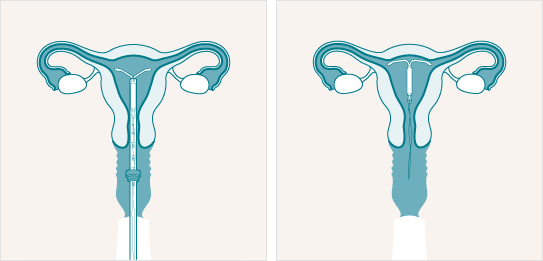Mirena IUS ® has revolutionised womens’ health worldwide in many ways.
There are three main indications for Mirena coil use:
1. As an effective long-term and reversible method of contraception.
It is fitted inside the uterus, where it releases a small amount of progesterone called levonorgestrol into the lining of the uterus. It inhibits fertilisation and prevents pregnancy, acting mainly locally for up to 5 years. The IUS can be removed at any time and fertility returns immediately. It can be fitted 6 weeks after delivery and it is suitable for breast feeding mothers. It does not affect milk production.
How does the Mirena work?
-
Thickens the mucous in the cervix (opening of the womb) so that sperm find it difficult to get through to fertilise the egg.
-
Changes the environment inside the uterus making it hostile for the sperm to move.
-
Keeps the lining of the womb thin thus inhibiting implantation
The Mirena IUS is designed to prevent fertilisation – the union of sperm and the egg.
The IUS affects the menstrual cycle. Some women might experience spotting or longer periods to begin with, but after some 3-6 months the periods become lighter, shorter and less painful. Some women may have no periods at all.
2. For reducing menstrual blood flow, if you suffer from heavy periods (heavy menstrual bleeding).
It can be used for heavy menstrual bleeding and contraception until it is removed or up to a maximum of 5 years. Mirena IUS is now recommended by the National Institute of Clinical Excellence (NICE) and the Royal College of Obstetricians & Gynaecologists as first line treatment for heavy and prolonged periods (menorrhagia/dysfunctional uterine bleeding).
3. If you are going through the menopause Mirena can be used in conjunction with an oestrogen as part of a hormone replacement therapy (HRT) regimen to protect the lining of your womb.
The menopause is a gradual process which usually takes place between the ages of about 45 and 55. Although the menopause is natural, it often causes distressing symptoms such as hot flushes and night sweats. These symptoms are due to the gradual loss of the female sex hormones (oestrogen and progestogen) produced by the ovaries.
Oestrogens can be used to relieve the menopausal symptoms. However, taking oestrogens alone increases the risk of abnormal growth or cancer of the lining of the womb. Taking a progestogen, such as the hormone in Mirena (levonorgestrel), as part of an HRT regimen lowers this risk by protecting the lining of the womb.
The hormone in Mirena reduces menstrual bleeding by controlling the monthly development of the womb lining, making it thinner, so that there is less bleeding every month.
How is the Mirena IUS inserted?
Preparations for the insertion procedure takes approximately 5 minutes, but the actual fitting of the system takes less than a minute. The Mirena is inserted into the womb through the vagina by using a specially designed introducer. Most women find that the fitting causes a little discomfort. If you are worried about possible pain during insertion, the use of painkillers before the fitting may be advisable.
Once your cervix has been cleaned with an antiseptic solution, the depth of the uterine cavity is measured and the intrauterine system is placed into the womb via a thin, flexible plastic tube.
How much does it cost to insert the Mirena IUS?
- Initial consultation – €50
- Mirena™ IUS Insertion – €150/€75 GMS
- Mirena™ IUS Removal – €50/Free GMS
- Mirena™ IUS Removal & Insertion – €150/€75 GMS
These services are free for GMS and private patients aged between 18-30. They are also free for GMS patients aged between 31-45 (not private patients).
How do I make an appointment?
Telephone 053 92 39512 to make an initial appointment with the doctor or to speak to one of our Family Planning Trained Nurses. You can also complete the on-line Contact Form

